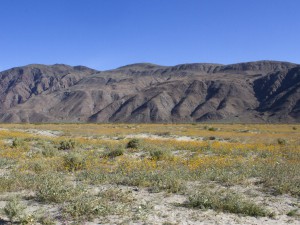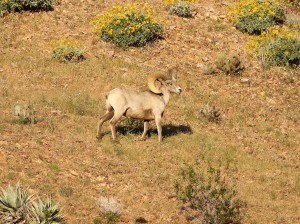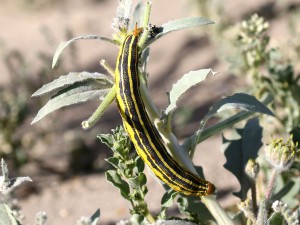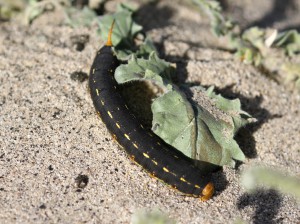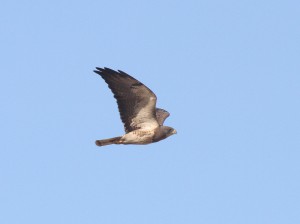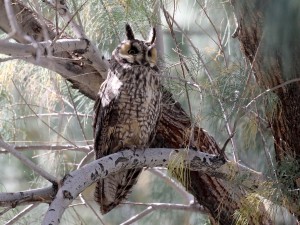Just when you think you understand things a little, along comes an event that puts you in your place! The rainfall here on the west coast of the United States in 2017 has been a bit odd. Very welcome, to be sure, but a bit odd. We greatly exceeded expected rainfall this winter and spring. From Washington down to northern California, experts declared an official end to a drought that lasted about a decade. This refilled reservoirs and lakes in that region to capacity.
In southern California, the rain didn’t erase that long drought as completely, but it still had staggering effects locally. One factor that makes the rain so odd is that it occurred completely outside the Pacific oscillation cycle. The El Nino and La Nina events govern these oscillations. These rains at Anza-Borrego State Park produced a huge wildflower super-bloom. That greatly benefited White-lined Sphinx moths and their predators.
Borrego – a.k.a. Desert Bighorn Sheep
Whenever southern California gets strong winter rains, it’s always great to visit Anza-Borrego State Park. There, and the area around the town of Borrego Springs respond to rain with a huge wildflower bloom. This wildflower explosion occurs, to some extent, annually, and it is always beautiful to see. But this year’s display was one of the best in decades. There hasn’t been a bloom like this one since 1997, which was an El Nino year, by the way. The rains are a boon to all kinds of wildlife in the desert around Borrego Springs. Even creatures superbly adapted to an existence without major rainfall welcome plentiful precipitation.
Driving to see the wildflowers, we found one of the region’s iconic creatures : Bighorn Sheep (Ovis canadensis nelsoni). In fact, “borrego” is a Spanish word for these sheep. Hence, the name of the park and town. We found a group of five Desert Bighorn rams among the boulders and cacti of a steep slope.
Sphinx Moth Caterpillars
The mass emergence of of the White-lined Sphinx Moth (Hyles lineata) caterpillars follows the winter rains and the wildflower bloom. The caterpillars always emerge en masse, as a way of avoiding predation. They use the sheer weight of numbers to ensure that at least some survive. The surviving ones pupate, emerge as moths and restart the cycle. Other insects, like mayflies and cicadas use this same strategy. The caterpillars devour the flowers with gusto. In years of less rainfall with fewer flowers, they can polish off a wildflower bloom in a matter of weeks.
The other survival tactic of the caterpillars is tremendous variability in color pattern. A typical White-lined Sphinx Moth caterpillar is lime green, with black and yellow stripes running the length of its body. Bright red spots often punctuate the black lines. But we also saw some caterpillars that had greatly reduced black so that they appeared more strongly green. Some had bright green heads and tails; others had orange or reddish heads and tails. The most extreme caterpillars showed completely black bodies, with just a few longitudinal dashed lines of yellow, green or orange.
What is the point of all this variability? The answer is that it helps ensure that some of the caterpillars will escape detection and survive. Who is doing the detection? Well that’s the next piece of this biological mosaic. There are multiple predators of the caterpillars, but the most prominent and magnificent is the Swainson’s Hawk.
Swainson’s Hawks
Swainson’s Hawks (Buteo swainsoni) are a migratory hawk of the western and central states. Their breeding range extends into eastern Alaska and western Canada. It includes 21 states, 6 Canadian provinces and 4 Mexican states. Virtually the entire population of Swainson’s Hawk winters in north central Argentina, thousands of miles south. As fits a long-distance migrant like that, Swainson’s Hawks have narrower, more-pointed wings than other buteos, for more efficient flight.
One population of Swainson’s Hawks migrates through the area of Anza-Borrego and Borrego Springs. There they take up residence for a week or two on their way north. The hawks time their arrival and departure to coincide with the sphinx moth caterpillar emergence, a delicate balance. Swainson’s Hawks arrive, gorge on caterpillars, regain their strength and then take off for more northern breeding grounds. It is likely, though difficult to prove, that hawk predation drives the emergence and camouflage strategy of sphinx moth caterpillars. This reminds us that the “natural selection” is always a negative event. Natural selection removes the unfit rather than selecting for the fittest. From a caterpillar’s point of view, becoming lunch constitutes a negative event!
Long-eared Owls
On the way home, we stopped at Tamarisk Campground, another unit of Anza-Borrego State Park. The campsites nestle into a large grove of Tamarisk trees. Birders know this spot well because historically, it often houses a roost of Long-eared Owls (Asio otus). Normally, one wouldn’t give away such a location because photographers and birders may disturb the roosting owls. Owls typically are very sensitive to such things. However, many people already know this site. So perhaps it may be of benefit as a place to learn about the beautiful owls through first-hand experience.
Sure enough, when we arrived, there were already people clustering around a single owl perched fortuitously in the open. We stopped and quietly took photos. When the crowd grew larger and noisier, we hushed them and explained why it was important. We were gratified at how well people responded to this instruction and complied with our requests. They became much more quiet, backing off a distance, and speaking only in hushed tones. All in all, it was a wonderful end to a very beautiful day.

